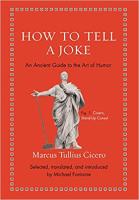
Princeton (2021) h/b 292pp £14 (ISBN 9780691206165)
F. is an Associate Professor in the Department of Classics at Cornell University. He specialises in making classical literature relevant to a modern audience and has recently engaged in a project, ‘Rebirth of Living Latin’, sponsored by the Paideia Institute, New York, which has objectives very similar to those of Classics for All. His previous books include an analysis of humour in Plautus.
How to Tell a Joke is the latest in the Princeton series ‘Ancient Wisdom for Modern Readers’. The format will be very familiar to Classic for All members who enjoy Bellaria—namely extracts of text in the original Greek or Latin, supported by a racy facing page translation and a few comments. The extended extracts in this book are from Cicero, De Oratore Book 2.216-290, and Quintilian, Institutio Oratoria Book 6.3. Cicero is indeed a favourite quarry for the Princeton series—7 out of the current 17 publications deploy his texts. F. has provided an earlier publication in the series—How to Drink—a translation of De Arte Bibendi by the German poet Vincent Obsopoeus (1498-1539, reviewed at:
https://classicsforall.org.uk/reading-room/book-reviews/how-drink-classical-guide-art-imbibing
This book should more accurately be entitled ‘How to tell a joke for a purpose’. All the discussion in both Cicero and Quintilian is about how to use humour in your speeches in order to improve your chances of getting a result. Whereas Demosthenes and Lysias used insults for the same purpose, Roman oratory seems to have preferred humour—albeit often quite mordant. Both Cicero and Quintilian attempt to analyse what works, what does not and why, and Cicero stresses that humour is divided into examples that rely on things for their effect in re and those that rely on language in dictu. Both authors are clear that words, while important, are only one aspect of a successful joke—how you present yourself matters—and Cicero gets close to saying never tell a joke that does not fit your personality. They both warn speakers to be wary of tanktraps—one counsel prosecuting a man of short stature made fun of his shortness, only to find that one of the jurors was an even shorter man and was being laughed at by his colleagues.
If the purpose of the series is to introduce relevant classical texts to a modern audience, the quality of the translation is clearly crucial. It seems, however, churlish in this context to be picky about the details. What matters is whether the reader can descry the spirit of the original text and apply it to the modern context. Given F.’s background, it is not surprising that much of the modern idiom chosen—‘schtick’, ‘thang’, ‘zingers’—is American based. There are also particular problems in translating jokes—most of which, particularly one liners, lose much of their impact by the need to set them in context before delivering them.
Puns have a difficulty all of their own. In one of the Yes, Minister episodes, Sir Humphrey muses to a colleague a propos a DWP minister ‘He wouldn’t know his ACAS from his NALGO’. Yes, Minister was translated into several languages, including Chinese and Finnish, and the mind boggles at the challenge. F. makes some valiant efforts to cope with the examples of puns cited by his authors (which sometimes need to be elucidated in the relatively sparse notes). At times too one is brought up short by the Tacitean compactness of which Latin is capable. Miror quid sit quod pater, homo constantissimus, te nobis varium reliquit is rendered ‘I just don’t get how your father—a paragon of independence—could leave us someone as ‘whipped’ as you’. The overall impact of the translation is perhaps worthy rather than scintillating—but that observation might also be levelled at the originals.
Will the result have the desired educational effect on modern readers? Clearly not on the current generation of British stand-up comics, given Quintilian’s clear direction to avoid like the plague telling dirty jokes or making a visual fool of yourself. Nor does it provide much of a quarry for anecdotes suitable for the dinner table—for a bumper fun book we miss the compilation by Tiro, Cicero’s freedman, of his master’s best efforts. Many of examples quoted by the authors come across as pretty feeble—possibly the crispest, though scarcely PC, one liner is a Sicilian response to the news that a neighbour’s wife had hanged herself on a fig tree— ‘can you get me a cutting?’ It is probably also not ideal for an classic British after- dinner speaker—by which is not meant a middle-aged sports professional recounting incidents of his mediocre career or a second rate comedian relating a series of increasingly off-colour jokes. The nearest example given by the authors of an after dinner approach is from Cicero, who, when defending a hopeless case, decided instead to ridicule Cato, the prosecuting counsel, with aspects of his Stoic lifestyle. The analysis of Cicero and Quintilian still, however, has value for politicians, diplomats, lawyers, clerics and other influencers who need to weave humour into their presentation.
One can only admire the rationale of the Princeton series and wish F. well with his Paideia project, which coheres so well with the aims of Classics for All. If for no other reason we should wish this publication well. In his recent article in The Times on this topic, Max Bridge says that those wanting to know more can attend an ecourse at Cornell for $3600, or watch a discussion on a Cornell website. It would be much easier and more profitable to spend £14 on the book.
Roger Barnes
